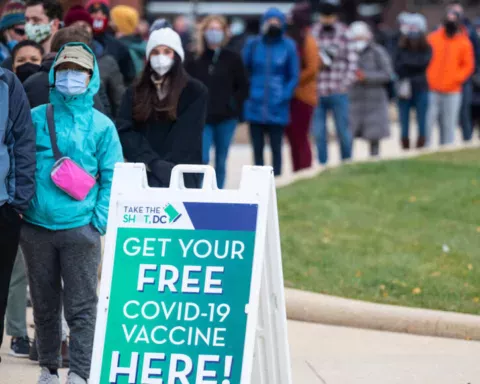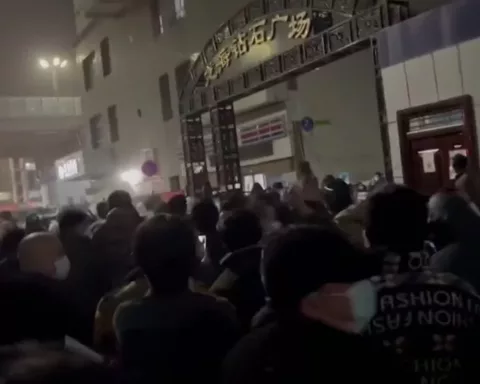The COVID-19 pandemic has magnified the many inequities between people and places in the United States, largely heaping health, social, and economic harms on the most vulnerable and least able to bear it.
As we contemplate the staggering number of people lost to COVID-19, city-watchers are also starting to ask if we are going to lose some places as well. Across the U.S., the pandemic has left downtowns “cratered,” “devastated,” and “abandoned.” In downtown Washington, D.C., for instance, daytime population plummeted 82% from February 2020 to February 2021, and only 9% of office space was occupied as of February 2021.
If these daytime populations do not rebound to pre-pandemic levels, a cascade of impacts will be felt far beyond downtowns. Small businesses will lose their customer base and close; transit systems will face unbearable budget gaps from absent farebox revenue; and commercial real estate tax assessments will shrink, leaving jurisdictions with long-term revenue shortfalls.
To be sure, concern about vacant downtowns is a far cry from the tragedy of lost lives. Yet as we contemplate recovery from the pandemic, there is a real opportunity to connect the healing of people to the healing of places.
DOWNTOWNS REVOLVE AROUND OFFICE SPACE
Downtowns are centrally located, highly accessible concentrations of assets. From a real estate perspective, contemporary downtowns are defined by the dominance of office space. In aggregate across downtown neighborhoods in the 30 largest U.S. metropolitan areas, offices make up 71% of real estate (Figure 1). In some downtown neighborhoods—such as the Golden Triangle in Washington, D.C. or the core of the Loop in Chicago—offices comprise over 90% of all space. Prior to the pandemic, downtown office spaces commanded premium rents per square foot, positioning these buildings as among the most valuable and high-tax-yield per acre in their jurisdictions.

Much like the suburbanization wave of the previous century, the pandemic pivot to telework has flatlined downtown activity and raised existential questions about its future. However, an examination of how downtowns weathered the Great Recession as well as post-recession job trends suggests that downtowns that creatively adapt can come back stronger than ever.
IN SOME PLACES, THE GREAT RECESSION HURT DOWNTOWNS WORSE THAN SURROUNDING REGIONS
Even before the pandemic, some American downtowns were already in trouble. As a group, downtowns weathered the Great Recession better than the rest of their metropolitan regions. Job loss occurred across the board, but downtowns lost relatively fewer jobs and incurred the loss more slowly
Taken together, however, downtowns were outpaced in the recovery. In 2011, areas outside downtowns in metropolitan regions started to add jobs faster than downtowns. Moreover, about one-third of the downtowns in the top 93 metropolitan areas continued to lose jobs during the post-recession period, falling below even their 2010 job levels (in Figure 3, these are the metro areas shown in orange).

Still, many downtowns either grew at a similar or faster rate relative to their regions after the Great Recession. The one-third of all downtowns that gained market share (i.e., grew faster than their regions) are shown above the dotted line in Figure 3 in blue, with the five downtowns that gained the most market share labeled. (These downtowns, along with those that lost the most market share, are also shown in Table 1.)

Changes in market share, especially for downtowns with low baselines, are just one way of understanding market strength—we also rank the downtowns that captured the most or the least job growth relative to their 2010 post-recession baseline and in absolute numbers. The first two metrics are relative, so some smaller or historically weaker downtowns starting from a low 2010 baseline stand out. The third measure is absolute and thus favors larger downtowns in high-growth regions. For example, downtown Los Angeles, Washington, D.C., and Philadelphia all lost regional market share but grew in absolute terms. Indianapolis, San Francisco, and Austin, Texas are particularly notable for ranking in the top 10 across all three metrics.
During this period, employers in the information, finance, and professional and business sectors demonstrated both strong job growth and a consistent preference for downtowns. Post-pandemic, the question is whether this source of downtown demand will also be a vital part of recovery.
THE POST-PANDEMIC OFFICE MAY BE SHAPED BY PRE-PANDEMIC TRENDS
COVID-19 is a profound stress test for downtowns. The dramatic growth in remote work is all but certain to impact demand for office space. Office landlords are also facing unexpected competition from hotels, which are in even deeper financial distress due to the pandemic’s effects on leisure and business travel, but also positioned to adapt their spaces to novel demands quickly. In many jurisdictions, lower rent revenues from office properties will soon result in a negative adjustment to office real estate tax assessments and, thus, commercial property tax revenue. Additionally, there are already secondary impacts to retail and hospitality businesses that cater to office workers, depressing sales tax receipts.
Some metro areas are more exposed to this weakening demand than others. For example, while Houston and San Francisco have comparably sized office markets, the share of the workforce using offices is twice as high in San Francisco (Figure 4). This suggests that there are relatively fewer other commercial land uses contributing to the San Francisco commercial tax base and supporting consumer demand, so the region may have less of a hedge against an office real estate downturn.
On the other hand, the Houston region’s current office vacancy rate is almost 50% higher than the San Francisco area (Figure 4). As of the first quarter of 2021, vacancy rates were over 10% in most of the biggest American office markets—a sign of market distress. As a lagging indicator, these vacancy rates reflect mostly pre-pandemic trends that were changing employers’ demands for the types, locations, and quantity of office space they need, rendering many existing office buildings obsolete. The pandemic will further reshape and compound these demand trends, and if and when COVID-19 is contained, it will leave behind a paradox of strong demand for new office construction in a context of high vacancy across regions.

DOWNTOWN REVITALIZATION REQUIRES CREATIVITY
Downtowns were once unique agglomerations of jobs and assets. However, long before the pandemic, they were facing competition from other activity centers in both downtown-adjacent and suburban locations. They now have peers even within their own regions; for example, downtown Dallas is competing with both adjacent Deep Ellum and CityLine in the next county north.
While no one is certain of the long-term scope of telework for office-using employers, we do know that telework was both available and growing before the pandemic. In that context, some downtowns were thriving and most kinds of jobs were clustering more densely than ever, either downtown or in suburban activity centers. Post-pandemic, the rise in telework may increase the growth of jobs in regional hubs rather than the singular, central locations that downtowns provide.
In order to remain vibrant and maintain a strong market position, some downtowns were rethinking their purpose before the pandemic—not only as a business district, but as a place where people can live, work, and play in diverse, creative ways.
The downtowns that bucked the regional tide by gaining job market share after the Great Recession are excellent models for post-pandemic recovery planning. The revitalization of downtown Greenville, S.C. is one example, especially development efforts along the Reedy River. Recognizing the river and its falls as unique natural assets, the city removed the four-lane Camperdown Bridge and turned it into a recreational hub, Falls Park and Liberty Bridge. This attracted more private investments in the downtown area.
Nashville, Tenn. and Austin, Texas have also brought life back to their downtown communities. Both downtowns have become more walkable and vibrant places by encouraging mixed-use developments, and have seen population growth over the past two decades. However, their booming economies have placed growing development pressures on artists and cultural places, which help downtowns build a sense of place and vitality. To preserve cultural assets while continuing revitalization momentum, both cities have recently made intentional efforts to serve those communities by providing place-based planning guidance and tools.
The metro areas that grew their job market share during the recovery from the Great Recession clearly demonstrate that resurgent demand for downtowns is possible. As a first step, regions with persistently high vacancy rates, very high exposure to office workforce trends, or both will want to consider adaptive reuse of obsolete office buildings. Each building presents unique adaptation challenges (some of which will be substantial enough to require gap financing or other incentives), but they are also opportunities for downtowns to reimagine and diversify themselves as neighborhoods that are active 24 hours a day.
Adaptive reuse can take many forms. Office-to-residential conversion is one big way to redefine who and what downtowns are for. Starting in 2006, the city of Phoenix and Arizona State University partnered to create a new downtown campus, beginning with renovated office buildings. Obsolete buildings have also been repurposed into schools, hotels, and self-storage facilities. More recently, as e-commerce and the demand for delivery services have risen rapidly, some developers converted vacant office buildings and retail space into last-mile industrial facilities or pick-up locations. One agri-tech startup has even showed the possibility of turning office spaces into urban vertical farms.
With COVID-19 hurting so many people and places, downtowns must think both boldly and inclusively. This is a critical moment to build equity into revitalization plans by implementing policy solutions that connect downtown prosperity to more neighborhoods. For example, increased development entitlements in downtown areas can be linked to neighborhood commercial corridor revitalization or open space preservation. Such reforms can both energize downtowns and expand their moral, political, and geographic relevance for the next generation of American city-building.
The authors thank Mark Muro and Adie Tomer for their help conceptualizing this piece, and Joseph Parilla, Alan Berube, Jennifer S. Vey, Dror Poleg, and Gerry Widdicombe for their invaluable review. However, any errors are the authors’ own.





